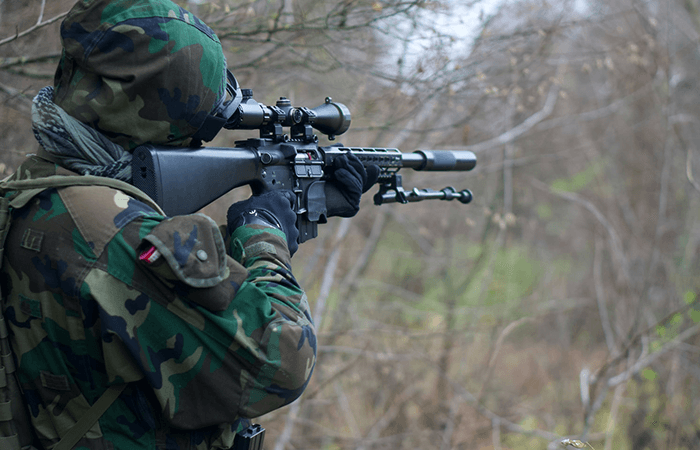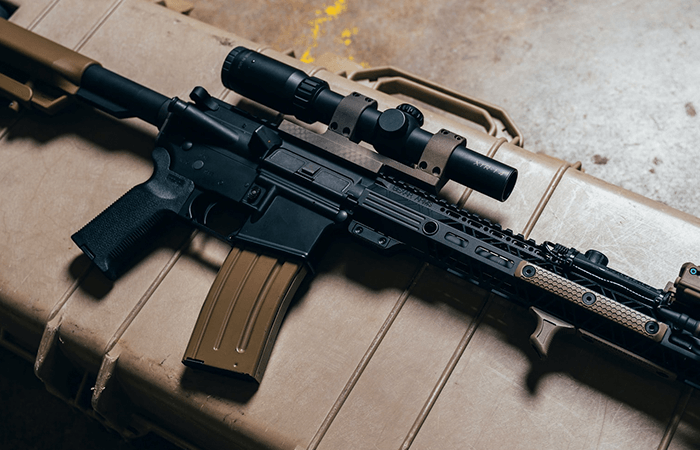Riflescopes are an essential piece of equipment for hunters. They allow you to see your target more clearly, which can be a life-saving tool when shooting at longer ranges.
The scope also helps you stay on target as it magnifies the view three times, allowing you to easily find your prey in brush and trees while eliminating any unnecessary movement that could throw off your shot.
In sum, rifle scopes are optical devices that use magnification and a reticle to improve your aim while shooting. When you purchase a good one, rifle scopes can extend your aim up to 400 yards (365.8 m).
In this article this article, we’ll cover the following details about rifle scope:
Rifle scopes assist carriers in plenty of ways, ranging from hunting and competitions to home defense. How you intend to use your rifle scope will determine which scope is best for you. Here are some different types of scopes to consider:
Fixed and Variable Power Scopes
Riflescopes come in two varieties: fixed and variable power. Fixed scopes list their magnification with a fixed set of numbers.
For example, a 3×32 scope can only magnify at three times the power, where variable scopes can change magnifying powers far more.
In a variable power scope, the eye relief will vary with the power but in a fixed scope, it is always the same. For instance, a scope listed as 3-9×32 can magnify anywhere between three and nine times the power.
Both kinds of scopes offer their set of benefits and drawbacks. Fixed scopes are less flexible, but their image quality is clearer and brighter than variable scopes. Furthermore, fixed scopes often cost less.
However, variable scopes offer more flexibility at the expense of image quality and a higher cost. Choosing between the two comes down to whether you plan to shoot at fixed or varying distances.
Reticles
Reticles are graphic image patterns on scopes that assist shooters with targeting. The designs displayed on reticles vary, making each one tailored for a different purpose. You should know the following three:
- Duplex Reticles are the least complex, consisting of a simple crosshair pattern. This simplicity makes them best for hunting and target shooting.
- Mildot Reticles also have a crosshair pattern, but they also include dots that reference a target’s distance based on size. These reticles are better for those in security, law enforcement, or the armed forces.
- Bullet Drop Compensating (BDC) Reticle (BDC) have marks at the bottom that gauge where a bullet will land on distance. Think of it as a bow sight for rifles. These reticles tailor to shooters who often pursue long-range targets.
How Do Rifle Scopes Work?
Before we can tell you what to look for, we should explain how rifle scopes do their job. The short answer is that a lens magnifies the image you are looking at while the reticle helps you target based on that image.
However, the inner workings of a rifle scope are more complex than that. The following diagram gives a more in-depth visual of how a scope works:
A rifle scope’s work starts at the front end. The objective lens transmits light to the lens closest to the viewer’s eyes, known as the ocular lens.
On its path to the ocular lens, the light passes from the objective lens to a focal point. From there, the ocular lens magnifies the image on that focal plane.
The reticle, or crosshairs, can exist in front of or behind the magnifying lenses. The placement of the reticle changes how it works.
For instance, first-focal-plane reticles are in front of the lens. First-focal-plane reticles adjust in size when the viewer changes magnification.
Second-focal-plane reticles, located behind the magnifying lens, work differently. These reticles maintain size, which means their size concerning the target changes with magnification.
Do You Need a Rifle Scope?

Some people may think that a rifle scope is an unnecessary addition, and it just weighs the gun down. I disagree with them – there are several advantages to using one!
If you’re still on the fence about whether or not to buy a rifle scope, let me tell you why they come in handy:
Longer Range
One of the most important factors that shape one’s shooting experience is range. Without it, shooters may not be comfortable in the field as they might be too close to a wild animal or too far from it and won’t have any chance when shooting. The lack of such an understanding will only put you at risk.
The rifle scope is a very helpful tool for individuals who want to shoot targets that are far away.
A longer range and an idea of the distance you’re aiming at gives more space, comfort, and confidence in shooting with greater accuracy. It allows you to take down your target with a higher success rate.
Increased Accuracy
The most exciting thing about using a rifle is hitting your target accurately. It makes you feel like a pro.
However, making a clean shot is not easy all the time. Because accuracy can be reduced by the field of vision at long distances and also an experienced shooter’s eyesight will deteriorate over time due to increased strain from shooting for extended periods of time.
For those reasons it might seem too difficult but don’t worry- there are ways around these challenges!
One way includes adding scopes which provide better clarity. When shooting in low light or bad weather conditions thanks to its high magnification power that reduces eye fatigue significantly.
In addition, it creates more stability through less movement and faster target acquisition. Sometimes, even cheap hunting optics can do the magic.
Extra Features
There are many different types of rifle scopes, and each one comes with unique characteristics. There is a lot to consider when you’re looking for the perfect scope that will suit your needs!
Think about how far away from your target these areas tend to get (the ranges), too: some people hunt rabbits; others shoot at targets which may only be several yards apart.
Is this something they do themselves? Will someone else use their scope instead? Do I need magnification power because the distances are so much further than usual?
Modern hunting optics come with add ons such as red dot, night vision, etc. These extra features will enhance your targeting significantly. With illumination adjustment and variable magnification, it is perfect for any hunter!
Comfort
Comfort is everything if you are to become a sharpshooter. You need to have an easy time aiming targets with your rifle and making each shot find its way home. A scope will give you the extra comfort that can make or break big game hunting.
There are hundreds of different types of scopes out there: some come in unique designs while others simply offer more features than other brands do .So first visit a store and then test them until one satisfies your needs.
Features such as light adjustments improve your vision since you can increase or reduce the amount of light reaching your eye when using it. If that isn’t comfort, then nothing else ever will be!
Like a good pair of boots, each hunter has their own opinion on which rifle scope is the best. So it’s no surprise that choosing the right scope depends on a hunter’s personal comfort and preference.
Boosting Self Confidence
A gun is an instrument of power that boosts confidence. To be successful at hitting any target, you need to have faith in yourself as well as the accuracy behind your aim; otherwise this might end up being one costly miss – literally
As a shooter, using it can help you improve your skills. The confident shots will ensure that you’re improving and can fuel the right mindset when setting goals for yourself long-term.!
Safety
If you are surprised, it can be because of your lack of knowledge on the use of rifle scopes. One reason for this is that they improve shooter safety in shooting at night.
It can be confusing during the night to tell whether an animal or a person is in the area. This can cause fatal injuries even death to another fellow hunter.
It is also possible for you to become the hunted when your prey realizes you can’t see them. Then they begin to circle around, hoping to maul or gore you. Luckily for you, there are rifle scopes with night vision.
Owning a scope with night vision ensures that you know what your target is and can spot whether or not it is potentially dangerous even in extreme low light conditions.
Extra Edge
Were you looking for an edge on your opponents in hunting competitions or shooting sports? Consider a rifle scope.
Shooters who use rifle scopes are more successful because of the extra features and greater accuracy. If you want to be a winner, invest in a rifle scope that will serve you well.
Buying a Rifle Scope – What to Consider?

When looking to by a new scope, consider checking the following specs to be sure you get the scope that is right for you.
Where some scopes will work for everyday use, some are very specific to the situation, such as long-range shooting.
Magnification
The magnification power you need comes down to the targets you shoot. Fixed 4x scopes and variable 3-9x scopes are standard for basic hunting. Additionally, “all-around” scopes sport a 4:1 ratio (think 2.5-10x or more).
However, long-distance shooting requires anywhere from 12x-20x. Furthermore, higher magnification scopes require a supported position.
Construction
Body sizes vary among rifle scopes, ranging anywhere from 25 to 34 mm (1 to 1.3 in) in diameter. What’s important to remember is that larger tubes support more components that increase the capacity for adjustments.
You will need these components when shooting long-distance. Furthermore, bigger scopes require specialized mounting rigs, which cost money.
Related reading: How Rifle Scopes are Made?
Coating
Another construction point to consider is coating. Any scope worth its price tag gets purged in nitrogen or argon. This will help to provide waterproofing, shock proofing, and to prevent fogging should you be using your scope in wet or humid weather.
Objective Lens
Objective lenses range from 20 mm to 72 mm (.8 to 2.8 in). What you need to know about objective lenses is that bigger lenses take in more light.
When viewing through a rifle scope, the round amount of light seen in the lens is referred to as the exit pupil. Dividing your objective lens by magnification will give you roughly how large this exit pupil is.
The exit pupil is a virtual aperture in optics that regulates the flow of light to your eye. The size of this opening determines how much light can enter, and consequently, it has an effect on however you decide to use your rifle scope for hunting or target shooting.
The more light a lens can take in, the brighter and more precise the image is. However, bigger objective lenses require a taller mount, which can mess with your sight alignment. The objective lens size comes after the magnification (i.e., 3-9×32 means 32 mm lens.).
Eye Relief
Eye relief is the space between the shooter’s eye and the ocular lens. The standard eye relief is 4in (101.6 mm).
However, if you are using a more powerful rifle, you will need more space than that. Eye relief protects your eye from injury by the gun’s recoil, making it a significant feature.
Reticle and Focal Planes
The type of reticle you need depends on how you use the rifle. Refer to the terms above: can you get by with a simple Duplex reticle, or do you need a BDC’s estimates?
Do you prefer the reticle to remain proportionate to the magnification (first-focal-plane)? Would you choose it to stay the same size (second-focal-plane)?
Parallax
As you deal with higher magnification powers, be aware of parallax. This scientific term refers to the optical illusion that occurs with magnification, which increases the margin of error of your aim.
Any high-end scope with powerful magnification should offer adjustment rings that help you adapt to the obstacles presented by parallax.
Turrets and Adjustments
This spec refers to the turrets located on the top and right of your scope. These knobs are essential because they control adjustments that accommodate windage and elevation. Make sure the scope you buy features reliable, audible turrets.
Related reading: What Is a Custom Turret and Do You Need One
Conclusion: What Is a Rifle Scope and Why Do I Need One
As you can see, the scope is an important piece of equipment when it comes to shooting rifles. Whether you are a hunter or target shooter, there is no doubt that having one will help improve your marksmanship skills and accuracy in general.
A rifle scope provides a number of advantages to its owner. When purchasing one, take the time to evaluate features so you can buy a scope that meets your needs as a shooter.
Related Articles
- How to Mount a Scope? Install a Rifle Scope Correctly
- How Rifle Scopes Are Made?
- Why Are Rifle Scopes So Expensive? Are They Worth It?
- How To Mount a Rifle Scope With Perfectly Vertical Crosshairs
- Are Scope Covers Necessary

